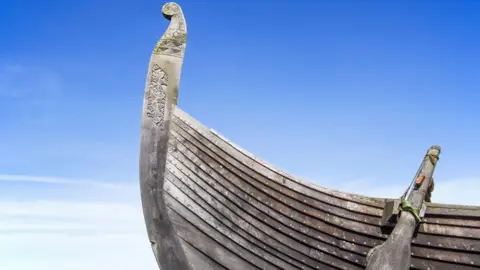 Getty ImagesVikings may have moved ships – similar to this replica of a vessel found in a Viking burial ground in Norway – across land in the west of ScotlandArchaeologists are investigating the possibility Vikings used shortcuts over land to help them move warships and smaller boats around Scotland's west coast.
Getty ImagesVikings may have moved ships – similar to this replica of a vessel found in a Viking burial ground in Norway – across land in the west of ScotlandArchaeologists are investigating the possibility Vikings used shortcuts over land to help them move warships and smaller boats around Scotland's west coast.
Tarbert in Kintyre is among potential locations where boats were dragged over low-lying land to reach different areas of sea and destinations beyond.
The practice, called portage, would have saved crews dangerous journeys by sea around the 40-mile (64km) long Kintyre peninsula.
Archaeologists said it was possible boats were hauled over split wood covered in slippery seaweed to make land crossings easier.
 Shane McLeodGerman project members set up equipment for a survey to find buried archaeological remainsThe research forms part of The Norse and the Sea project led by the University of the Highlands and Islands' Institute for Northern Studies.
Shane McLeodGerman project members set up equipment for a survey to find buried archaeological remainsThe research forms part of The Norse and the Sea project led by the University of the Highlands and Islands' Institute for Northern Studies.
The three-year project is in its final year and involves researchers from Germany.
It has been gathering evidence of Viking age communications and other activity that occurred 800 to 1,200 years ago, particularly in and around the Inner Hebrides.
Evidence of portages survive in Old Norse place names both in the Northern Isles and Hebrides, and the project team said there were several clues to Tarbert being used as a shortcut between the Firth of Clyde and the Inner Hebrides.
The group of islands include Islay, Gigha and Iona, where monasteries were attacked by Vikings.
The archaeologists said Tarbert's Gaelic name means "over bringing" suggesting the carrying of boats.
There is also a Tarbert on Gigha with a standing stone visible from the sea and believed to have been used as a navigational aid.

About the author